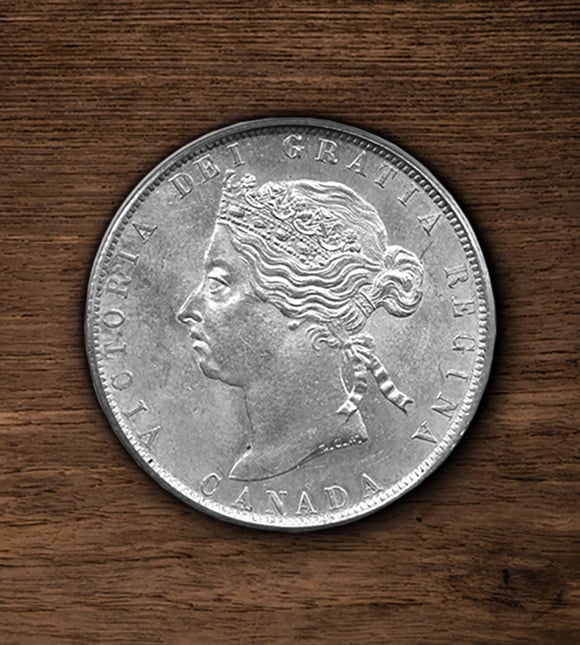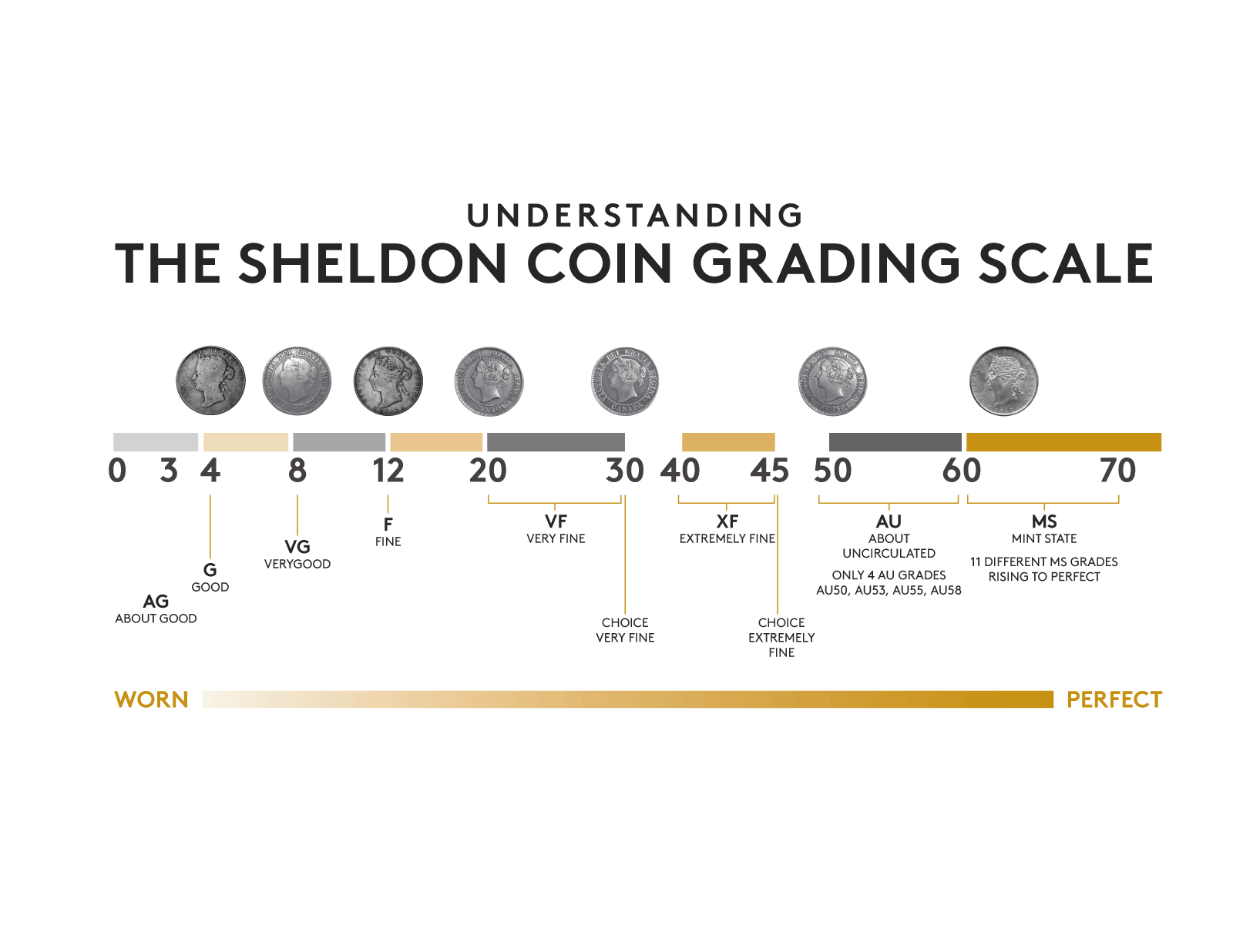What’s the score? Your guide to coin grading
- May 13, 2024
- Learn
- 5 minutes read
PO-1, VF, MS-69… You’ve seen these terms in coin guides or online listings, but what does it all mean? When determining a coin’s value, one of the biggest factors is its grade: a “score” that indicates the coin’s state of preservation and, to a lesser extent, the quality of the engraving or strike.
Admittedly, coin grading can feel a bit subjective at times, especially if your piece is assessed at a lower grade than expected due to something minor. It’s not unusual for dealers and collectors to have different interpretations, and that makes grading one of the more contentious aspects of coin collecting. But without it, coin values would be a lot more arbitrary; a coin that looks “good for its age” might not look good, period, and that’s the reason a grading standard exists: to provide an objective assessment of a coin’s state of preservation.
A trained eye and years of experience are required for accurate grading, and that’s why many numismatists submit their most important coins to third-party services for certified grading and authentication.
You can also approximate a coin’s grade yourself; it just takes careful research and study, plus a clear understanding of the criteria that can determine whether a coin is worth a few dollars or a few hundred or thousand dollars.


Image courtesy Royal Canadian Numismatic Association
PO-1, VF, MS-69… You’ve seen these terms in coin guides or online listings, but what does it all mean? When determining a coin’s value, one of the biggest factors is its grade: a “score” that indicates the coin’s state of preservation and, to a lesser extent, the quality of the engraving or strike.
Admittedly, coin grading can feel a bit subjective at times, especially if your piece is assessed at a lower grade than expected due to something minor. It’s not unusual for dealers and collectors to have different interpretations, and that makes grading one of the more contentious aspects of coin collecting. But without it, coin values would be a lot more arbitrary; a coin that looks “good for its age” might not look good, period, and that’s the reason a grading standard exists: to provide an objective assessment of a coin’s state of preservation.
A trained eye and years of experience are required for accurate grading, and that’s why many numismatists submit their most important coins to third-party services for certified grading and authentication.
You can also approximate a coin’s grade yourself; it just takes careful research and study, plus a clear understanding of the criteria that can determine whether a coin is worth a few dollars or a few hundred or thousand dollars.
Meet Sheldon
First developed in 1949, the Sheldon Grading Scale has evolved to become the standard in many countries, including Canada and the United States.
Every coin grade has two components: a letter (or two) and a numeric value. That value is based on a scale of 1 to 70, with 70 (or Mint State/MS-70) being the mark of perfection.
A Canadian coin’s lustre (that “freshly minted” shine), its level of preservation and the quality of the strike (the sharpness of the engraving) will determine its “score” under this system.
With Mint State coins in particular (and more on that later), “eye appeal”—the quality of the lustre and the existence of attractive, original toning—can also have a positive impact on the grading “score” assigned to a coin. Generally, the higher the grade, the more valuable (and rare) your coin tends to be, because it is considered one of the best examples of its kind.
But there are a lot of nuances between those ratings, even on the lower end of the scale—for example, a piece with some heavy wear can be assigned either a VG-8 or a slightly higher VG-10 grade, based solely on the sharpness of the letters or numerals.



Where does my coin fit on the scale?
All circulated coins fall somewhere on this spectrum:
- Poor (PO-1): The design is barely recognizable but the date can be made out.
- Fair (FR-2): A very heavily worn coin, but a few engraved elements—including the date—are visible.
- About/Almost Good (AG-3): Some letters and/or numerals, including the date, are readable.
- Good (G-4, 6): Heavily worn but you can make out the outline of some design elements, including the date.
- Very Good (VG-8, 10): Medium to heavy wear; major design elements are visible.
- Fine (F-12, 15): Medium wear but lettering is visible; some weakness or lack of details, especially on the highest spots.
- Very Fine (VF-20, 25, 30, 35): Medium to light wear with loss of lustre; all major details, plus a few finer ones, are visible.
- Extremely Fine (XF/EF-40, 45): Light wear, mostly on the highest points. Some of the original lustre is visible.
- About/Almost Uncirculated (AU-50, 53, 55, 58): Signs of wear on less than 50% of the design, and at least 50% of the original lustre.
Uncirculated (Unc.) or Brilliant Uncirculated (BU) coins are those that show no signs of wear at all. These are generally assigned a higher grade known as Mint State (MS):
- Uncirculated (MS-60, 61, 62): Abrasions in the open fields of the coin. Marks or scuffs on the coin, particularly on the monarch’s portrait.
- Select Uncirculated (MS-63): Contact marks that are obvious to the naked eye. Some loss of lustre.
- Choice Uncirculated (MS-64): Moderate contact marks in less distracting areas. Lots of original lustre or toning.
- Gem Uncirculated (MS-65, 66): Minimal markings or imperfections, a nice original look with a good strike showing detail on the high points of the coin.
- Superb Gem Uncirculated (MS-67, 68, 69): Exceptional coins with only miniscule imperfections, a lot of “eye appeal” and a good strike.
- Perfect Uncirculated (MS-70): A flawless specimen, even at 5x-8x magnification. A full sharp rim. This grade seldom applies to anything but modern, specially struck coins.
What about PR/PF and SP? These prefixes stand for Proof and Specimen, respectively, and they’re typically used instead of MS to denote uncirculated coins struck specifically for collectors or as presentation pieces to dignitaries, heads of state, etc. (Think “Mint State” or MS for uncirculated circulation coins, and “Proof” or PF for modern, specially struck collector coins.)
Ready to grade
Now that you understand the different grades, here are a few tips:
Be sure to have good lighting. You want to be able to see every minute detail, but be aware that some types of bulbs can emit too soft or too harsh of a light, which may make some features look more significant than they actually are. Often, incandescent bulbs are preferred by experienced graders.
Always view your coins under the same light. Hold your coin by the edge, about a ruler’s length (30 centimetres or 12 inches) away from your light source and tipped at a 45-degree angle. Do this for all your coins (consistency is key) and before viewing them under magnification, just to get an overall sense of each piece (is it appealing?).
Use a magnifying glass. The small variations or markings that make a big difference are easier to view under 5x or 8x magnification.
Don’t sweat the small stuff (not too much, anyway). It’s easy to get caught up in trying to find imperfections, but don’t focus exclusively on the flaws. Take it all in—the art, the shine, the craftsmanship—otherwise, you risk under-grading your coin.
Consult references. A lot of coin guides and community-created resources can provide you with more detailed explanations and/or photos to help break down the different grades.
Congratulations! Now that you’ve approximated your coin’s grade, you’re that much closer to knowing your coin’s value.


Our thanks to the Royal Canadian Numismatic Association (RCNA) and to Mr. Henry Nienhuis, F.R.C.N.A., F.C.N.R.S., for their valuable contribution to this post. One of the world’s largest numismatic associations, the RCNA is devoted to serving those who enjoy coin collecting and Canadian numismatics, and to promoting fellowship and education through events, workshops and correspondence courses. To learn more, visit www.rcna.ca or [Facebook: @TheRCNA]



